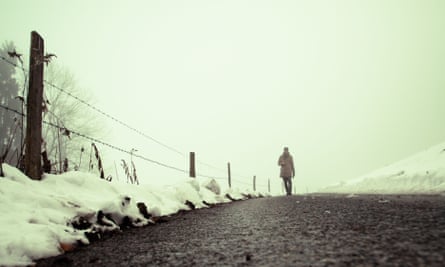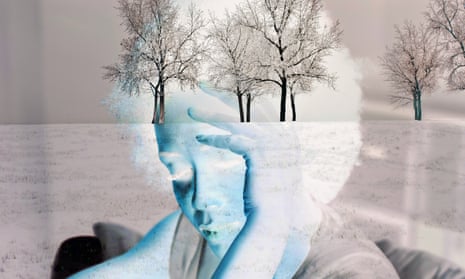For many of us in the UK, the annual ritual of putting the clocks back for daylight saving time can be accompanied by a distinct feeling of winter blues as autumn well and truly beds in. This might be felt as a lack of energy, reduced enjoyment in activities and a need for more sleep than normal. But for around 6% of the UK population and between 2-8% of people in other higher latitude countries such as Canada, Denmark and Sweden, these symptoms are so severe that these people are unable to work or function normally. They suffer from a particular form of major depression, triggered by changes in the seasons, called seasonal affective disorder or Sad.
In addition to depressive episodes, Sad is characterised by various symptoms including chronic oversleeping and extreme carbohydrate cravings that lead to weight gain. As this is the opposite to major depressive disorder where patients suffer from disrupted sleep and loss of appetite, Sad has sometimes been mistakenly thought of as a “lighter” version of depression, but in reality it is simply a different version of the same illness. “People who truly have Sad are just as ill as people with major depressive disorder,” says Brenda McMahon, a psychiatry researcher at the University of Copenhagen. “They will have non-seasonal depressive episodes, but the seasonal trigger is the most common. However it’s important to remember that this condition is a spectrum and there are a lot more people who have what we call sub-syndromal Sad.”
Around 10-15% of the population has sub-syndromal Sad. These individuals struggle through autumn and winter and suffer from many of the same symptoms but they do not have clinical depression. And in the northern hemisphere, as many as one in three of us may suffer from “winter blues” where we feel flat or uninterested in things and regularly fatigued.

One theory for why this condition exists is related to evolution. Around 80% of Sad sufferers are women, particularly those in early adulthood. In older women, the prevalence of Sad goes down and some researchers believe that this pattern is linked to the behavioural cycles of our ancient ancestors. “Because it affects such a large proportion of the population in a mild to moderate form, a lot of people in the field do feel that Sad is a remnant from our past, relating to energy conservation,” says Robert Levitan, a professor at the University of Toronto. “Ten thousand years ago, during the ice age, this biological tendency to slow down during the wintertime was useful, especially for women of reproductive age because pregnancy is very energy-intensive. But now we have a 24-hour society, we’re expected to be active all the time and it’s a nuisance. However, as to why a small proportion of people experience it so severely that it’s completely disabling, we don’t know.”
There are a variety of biological systems thought to be involved, including some of the major neurotransmitter systems in the brain that are associated with motivation, energy and the organisation of our 24-hour circadian rhythms. “We know that dopamine and norepinephrine play critical roles in terms of how we wake up in the morning and how we energise the brain,” Levitan says. One particular hormone, melatonin, which controls our sleep and wake cycles, is thought to be “phase delayed” in people with severe Sad, meaning it is secreted at the wrong times of the day.
Another system of particular interest relates to serotonin, a neurotransmitter that regulates anxiety, happiness and mood. Increasing evidence from various imaging and rodent studies suggests that the serotonin system may be directly modulated by light. Natural sunlight comes in a variety of wavelengths, and it is particularly rich in light at the blue end of the spectrum. When cells in the retina, at the back of our eye, are hit by this blue light, they transmit a signal to a little hub in the brain called the suprachiasmatic nucleus that integrates different sensory inputs, controls our circadian rhythms, and is connected to another hub called the raphe nuclei in the brain stem, which is the origin of all serotonin neurons throughout the brain. When there is less light in the wintertime, this network is not activated enough. In especially susceptible individuals, levels of serotonin in the brain are reduced to such an extent that it increases the likelihood of a depressive episode.

Serotonin may also explain why women are so much more vulnerable to Sad than men. “There’s a close connection between estradiol, the main female sex hormone, and the serotonin transporter,” McMahon says. “We have a good idea that the fluctuating levels of estradiol during certain phases such as puberty or postpartum, can affect the way serotonin is produced.”
Some populations appear to be particularly resilient to Sad, mostly notable in Iceland. “Icelanders seem to be genetically protected from Sad,” Levitan says. “When they move to locations which have high rates of Sad such as Canada, their rates are much lower than their peers.” One possible reason for this could again be linked to serotonin. There are different variants of a gene that controls how the serotonin transporter behaves, and one particular variant found in resilient individuals actually causes our bodies to increase the production of serotonin during the wintertime.
For those on the Sad spectrum, there are a variety of treatments available, the most popular being bright-light therapy, an artificial means of stimulating the brain’s neurotransmitters. “It’s very important to use a Sad-specific ultraviolet filtered light otherwise it can be dangerous,” says Levitan. “But it can really enable people with Sad to get their day started earlier and avoid oversleeping, which can be very depressogenic. It’s probably effective in providing symptom relief in around 80% of patients, particularly those with the carbohydrate craving, oversleeping symptoms. For the most severe patients, though, it may have to be combined with antidepressant therapy.”
However, psychiatrists urge patients to steer clear of some of the many alternative therapies on the market. “There’s a range of new technologies people are developing, such as an earplug that is supposed to radiate light into your brain, but there’s no science to prove that this actually works,” McMahon says. “However, there are some good additions to conventional light therapy and antidepressants, such as tryptophan, an amino acid that gets converted to serotonin in our bodies, which can be given as an add-on treatment.”










Comments (…)
Sign in or create your Guardian account to join the discussion